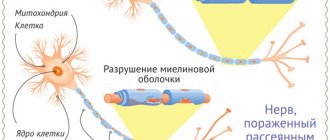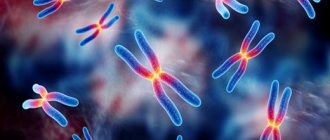Alzheimer's disease
is a chronic, progressive disease that impairs memory, thinking and movement. Some studies show that a person is at increased risk of developing Alzheimer's disease if they have a relative with the disorder.
Alzheimer's disease
is the most common cause of dementia and can seriously affect a person's ability to think, make judgments and carry out everyday tasks. Doctors have known about Alzheimer's disease for years, but many aspects of the condition and possible treatments remain unknown. The causes of Alzheimer's disease are unclear. Modern research shows that many factors can contribute to the development of Alzheimer's disease, one of which is genetics or heredity.
Is Alzheimer's disease inherited?
Scientists describe genetic risks for Alzheimer's disease in terms of two factors: risk genes and determinant genes.
When a person has risk genes, it means they are more likely to develop the disease. For example, a woman with the BRCA1 and BRCA2 genes has a higher risk of developing breast cancer.
Determined genes can directly cause the development of the disease.
Scientists have discovered several risk and deterministic genes for Alzheimer's disease.
How does disease transmission occur?
Many people are interested in the question of how Alzheimer's disease is transmitted, because this disease makes it impossible not only to remember one's loved ones, a person loses the ability to remember how to hold a mug or how to write a letter. According to scientists, only in 15 percent of cases (dementia) is inherited and in 79 percent of cases it is detected in a person if the disease was registered in the parents. When familial dementia occurs, Alzheimer's disease develops before age 50. The genetic factor ranks first in the transmission of the disease.
Extensive genomic studies for Alzheimer's disease risk loci
It should be noted that with allelic heterogeneity, the association would be successful if the association tests did not give a positive result.
However, each of them reported interesting results. No annotated gene was found in this genomic region in the UC Santa Cruz database, except for the computationally predicted gene and three expressed sequence tags. Perhaps most interestingly, the authors reported that of the top 19 distinct signals, 12 were found in regions with prior connectivity data, consistent with the expectation of enrichment for true signals. The direct involvement of products from at least three known genes in this hypothesis is not a coincidence and greatly increases confidence that this is a promising treatment target.
Risk genes
Several genes pose a risk for developing Alzheimer's disease. The gene with the most significant association with Alzheimer's disease is the apolipoprotein E-e4 (APOE-e4) gene. About 20-25% of people with this gene may suffer from Alzheimer's disease. A person who inherited the APOE-e4 gene from both parents has a higher risk of developing Alzheimer's disease than a person who inherited the gene from only one. Having the gene may mean that a person exhibits symptoms at an earlier age and is diagnosed earlier. Other genes may influence late-stage Alzheimer's disease and its progression. Scientists need to do more research to find out how these genes increase the risk of developing Alzheimer's disease.
Some of these genes regulate certain factors in the brain, such as inflammation and the way nerve cells communicate. While everyone inherits the APOE gene in some form, the APOE-e3 and APOE-e2 genes have no connection with Alzheimer's disease. APOE-e2 may even have a protective effect on the brain against the disease.
The smell of fatty foods leads to decreased appetite
Illustration copyright Unsplash
New data has emerged on the effect of smell on appetite. A group of American biologists discovered that inhaling the aroma of fatty foods for more than two minutes suppresses the receptors that control hunger.
The time factor here turns out to be decisive - the first reaction to the smell is an attack of hunger, but prolonged exposure to the smell suppresses it.
- A sickening food that some consider a true delicacy
- The smell of fresh bread and hot chocolate. How we are forced to buy
“Indoor odor can be a powerful appetite suppressant,” notes one of the researchers, Dipayan Biswas, from the University of South Florida.
Scientists are already proposing to use this technique in school canteens or large grocery stores. They tested it in practical experiments, spraying the aromas of apples, strawberries, pizza and pastries in such rooms.
In a typical school cafeteria in the United States, where about 900 schoolchildren gather for lunch, the evaporation of a pizza-scented substance reduced the number of unhealthy food choices to 21.43%. The smell of apples led to a decrease in such purchases to 36.96%, and the absence of the smell gave a figure of 36.54%.
Scientists explain these results by the fact that the human brain is not able to distinguish sources of pleasant sensations accurately enough.
“We hypothesize that odors associated with foods that are particularly attractive activate reward centers in the brain, causing satisfaction, which in turn reduces actual consumption of such foods,” the paper states.
So don’t be surprised if during your next flight you smell a strong smell of pizza in the cabin - perhaps the airline is trying to influence your appetite in the direction of reducing it.
The article is published in the latest issue of the Journal of Marketing Research.
Determined genes
Researchers have identified three specific deterministic genes that may cause Alzheimer's disease:
- amyloid beta precursor (APP)
- presenilin-1 (PS-1)
- presenilin-2 (PS-2)
These genes are responsible for excessive accumulation of amyloid beta peptide, a toxic protein that accumulates in the brain and causes nerve cell damage that is characteristic of Alzheimer's disease. However, not all people with early-onset Alzheimer's disease have these genes. A person with these genes who develops Alzheimer's disease has a rare type known as familial Alzheimer's disorder. Familial Alzheimer's disease accounts for less than 5% of all cases worldwide. Alzheimer's disease, caused by genetic determinants, usually occurs before age 65. Sometimes it can develop in people aged 40-50 years.
Methods of transmission of the disease
Scientists identify two main modes of transmission of the disease, divided by genotypes.
Inheritance of pathology in the first scenario occurs rarely, but in this case the disease develops with 100% probability. Signs usually appear before old age. Persons with this form of predisposition are recommended to undergo special tests at a young age, get advice from a geneticist, and begin intensive prevention.
Heredity according to the first genotype comes in several varieties:
- 1st chromosome - only a few dozen families are at risk. The clinical picture develops quite late;
- 14th chromosome - 400 families with a mutation of this gene are officially registered on the planet. The peculiarity is that against such a background, senile dementia develops very early. Cases of diagnosis at 30 years of age have been reported;
- Chromosome 21 - damage to the gene leads to the development of a pathology called familial Alzheimer's disease. Approximately a thousand families around the world have been diagnosed. The first obvious signs of degenerative changes in the brain are detected at 30-40 years of age.
Chromosome 21 - damage to the gene leads to the development of a pathology, which is called a familial disease, the diagnosis has been made to approximately a thousand families around the world.
Inheritance by the second genotype is diagnosed much more often. It can be triggered by a number of genes, the most well studied of which is apolipoprotein. Its mutation can be detected using special tests, but this approach is still used quite rarely. This type of heredity becomes not the cause of the disease itself, but a predisposition to changes in the structure of the nervous tissue.
Gene influence on other types of dementia
Some types of dementia are associated with other genetic defects.
Huntington's disease
, for example, is caused by a change in chromosome 4, which can manifest as progressive dementia. Huntington's disease is a dominant genetic disorder. This means that if one parent has the disease, they can pass the gene on to their offspring and they will develop the disease. Symptoms of Huntington's disease usually do not appear until age 30 to 50. This can make it difficult for doctors to predict and diagnose before a person has children and passes on the gene.
Researchers believe that Lewy body dementia, or Parkinson's disease dementia, may also have a genetic component. However, they believe that other factors not related to genetics may also play a role in the development of these conditions.
Risk factors for developing Alzheimer's disease
Researchers have identified several risk factors for developing Alzheimer's disease. These include:
Age
: The most significant risk factor for developing Alzheimer's disease is age. People over 65 are more likely to develop Alzheimer's disease than younger people. By age 85, 1 in 3 people have this condition.
Family history
: Having a close relative with Alzheimer's disease increases your risk of developing it.
Head injury
: People with a history of severe head trauma, such as from a car accident or contact sports, are at higher risk of developing Alzheimer's disease.
Heart Health
: Cardiovascular health problems may increase your chance of developing Alzheimer's disease. Examples include high blood pressure, ischemic stroke, diabetes, heart disease and high cholesterol. The conditions listed above can damage blood vessels in the brain, which affects the risk of developing Alzheimer's disease.
Forms of predisposition
Based on which chromosome is affected and how many genes are involved in the process, two main forms of predisposition are distinguished. In the first case, only one gene is affected, in the second – several. Each option has its own characteristics, which must be taken into account during diagnosis, prevention, and treatment.
Monogenic
The mutation occurs in one of the genes of the 1st, 14th or 21st chromosomes. The difficulty of making a diagnosis in this case is due to the lack of accurate information among geneticists on all fragments of human DNA. Some of the genes have not yet been identified, which sometimes makes it impossible to identify the pathological link, despite the obvious influence of the hereditary factor.
The difficulty of making a diagnosis in this case is due to the lack of accurate information among geneticists on all fragments of human DNA.
Polygenic
The main mode of transmission of Alzheimer's disease is genetic. If a person’s ancestors have not one altered DNA fragment, but several, then this can manifest itself in a variety of combinations. It is noteworthy that, despite the defeat of several genes at once, the development of senile dementia does not always occur against such a background.
Today, genetics includes two dozen types of gene mutations that can increase the risk of developing Alzheimer's syndrome. In the presence of a hereditary predisposition, the influence of external factors on the body plays an important role.
Pathology of this type usually appears after 65 years, but the first vague signs can be noticed 5-7 years earlier. The more confirmed cases of the disease in a family, the higher the potential risks.
Early signs of Alzheimer's disease
Alzheimer's disease is usually accompanied by a gradual loss of memory and brain function. Early symptoms may include periods of forgetfulness or memory loss. Over time, a person may experience confusion or disorientation in familiar environments, including at home.
Other symptoms may include:
- changes in mood or personality
- confusion about time and place
- difficulty with routine tasks such as doing laundry or cooking
- difficulty recognizing objects
- difficulty recognizing people
The aging process can naturally deteriorate a person's memory, but Alzheimer's disease leads to longer periods of forgetfulness.
Over time, a person with Alzheimer's disease may need more and more assistance with activities of daily living, such as brushing teeth, getting dressed, and eating. They may experience agitation, restlessness, personality disorders and speech problems. The life expectancy of a person with Alzheimer's disease is usually 8 to 10 years after the first symptoms of the disease appear.
Because people with advanced Alzheimer's disease are unable to care for themselves or may not understand the importance of food, common causes of death include malnutrition, malnutrition, or pneumonia.
When to see a doctor
Seeking medical help for a person who has these symptoms is vital. Your doctor can rule out other conditions that may cause dementia, such as a urinary tract infection or a brain tumor.
Family members should make a list of all medications the symptomatic person is currently taking. Your doctor can review the list to make sure your dementia symptoms are not side effects of medications.
Identifying noticeable symptoms and their progression can help the doctor identify potential patterns. Although genetic testing is available, doctors generally do not recommend it. Having the genes does not necessarily mean a person will have the condition, and testing may cause unnecessary anxiety and fear. However, a person with a family history of early Alzheimer's disease may wish to undergo genetic testing. Most doctors recommend meeting with a genetic counselor ahead of time to discuss the pros and cons of genetic testing and how they might interpret the results.
Sometimes a doctor may recommend genetic testing when a person exhibits early symptoms of Alzheimer's disease, as this may dictate possible treatments.
Influence of heredity
Speaking about the causes of Alzheimer's disease, heredity plays a major role in disrupting the functioning of the body and the development of the disease. Less than ten percent of cases under the age of 60 are associated with autosomal dominant mutations, meaning the disease spreads among family members. Thus, identified mutations in the APP genes (on chromosome 21) enhance the synthesis of a special protein that promotes the formation of brain plaques.
Authors original submitted files for images
Genome research. Non-steroidal anti-inflammatory drug. Single nucleotide polymorphism. University of California Santa Cruz. The author thanks Dr. David Valle and Megan Szymanski for critical review of the manuscript. The author declares that he has no competing interests.
Video on the topic
Institute of Genetic Medicine named after. McKusick Nathans and Department of Psychiatry, Johns Hopkins University School of Medicine. Evidence of a new locus on the chromosome. . We describe the clinical phenotype and pathology of a novel autosomal dominant late-onset familial form of Alzheimer's disease in four extensive relatives arising from a genetically isolated population. Twelve affected and 16 unaffected members of these relatives were examined clinically, and post-brain In one case, a single study was performed: preliminary genetic evaluation included comprehensive segregation analysis, assessment of the ability to detect association, and exclusion of candidate genes.
Important! If your relatives are diagnosed with Alzheimer's disease, you will need to conduct a genetic study, because at this stage it is possible to prevent the development of the disease.
In studies of relatives of patients, the presence of a gene mutation determines the risk of Alzheimer's disease. If the E4 variant of the APOE gene is inherited, a late sporadic form of the disease may appear. According to genetic research, approximately 400 genes in the human body can contribute to or hinder the development of the disease. For example, an increased susceptibility to developing Alzheimer's disease in women is associated with a variation in the RELN gene.
Early signs and symptoms of Alzheimer's disease
Dementia has been documented for six generations in the ancestors of the cases in question. Allowed all subjects to be linked to four broad family trees. Individuals studied had progressive memory loss with onset between 57 and 74 years of age, as well as seizures, myoclonus, and parkinsonism in advanced stages. The brain of the case in question, upon autopsy, showed widespread neocontactic neuritic plaques and neurofibrillary tangles, amyloid angiopathy, and Lewy bodies limited to limbic areas.












